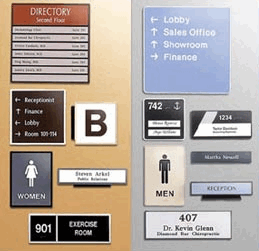Personalizing ADA Signs to Fulfill Your Specific Needs
Checking Out the Secret Features of ADA Indicators for Enhanced Ease Of Access
In the realm of access, ADA signs serve as quiet yet powerful allies, guaranteeing that areas are accessible and comprehensive for individuals with handicaps. By integrating Braille and responsive components, these indicators break barriers for the aesthetically damaged, while high-contrast color schemes and legible font styles cater to diverse aesthetic requirements.
Relevance of ADA Compliance
Guaranteeing compliance with the Americans with Disabilities Act (ADA) is vital for promoting inclusivity and equivalent accessibility in public spaces and offices. The ADA, passed in 1990, mandates that all public centers, employers, and transportation services suit individuals with specials needs, guaranteeing they enjoy the same legal rights and possibilities as others. Conformity with ADA standards not only satisfies lawful commitments but likewise improves a company's credibility by demonstrating its dedication to diversity and inclusivity.
One of the crucial elements of ADA conformity is the implementation of obtainable signs. ADA signs are designed to make sure that people with specials needs can quickly navigate with spaces and structures.
Additionally, sticking to ADA guidelines can minimize the danger of lawful effects and potential penalties. Organizations that fall short to abide by ADA guidelines may deal with charges or claims, which can be both monetarily difficult and damaging to their public photo. Thus, ADA conformity is essential to promoting a fair setting for everyone.
Braille and Tactile Elements
The consolidation of Braille and tactile elements into ADA signage embodies the concepts of availability and inclusivity. It is normally put beneath the corresponding text on signs to make sure that individuals can access the information without visual aid.
Tactile elements prolong beyond Braille and include increased signs and characters. These components are designed to be noticeable by touch, enabling individuals to identify space numbers, toilets, leaves, and other essential areas. The ADA sets particular guidelines regarding the dimension, spacing, and positioning of these tactile components to enhance readability and make certain uniformity throughout different environments.

High-Contrast Color Design
High-contrast shade schemes play a crucial role in boosting the exposure and readability of ADA signs for individuals with visual disabilities. These plans are crucial as they maximize the distinction in light reflectance between message and background, making certain that indications are conveniently discernible, also from a range. The Americans with Disabilities Act (ADA) mandates using specific shade contrasts to accommodate those with restricted vision, making it a crucial aspect of compliance.
The efficacy of high-contrast colors hinges on their capability to attract attention in various lights conditions, consisting of dimly lit environments and locations with glow. Generally, dark text on a light background or light text on a dark history is utilized to achieve optimum comparison. Black message on a yellow or white history gives a stark visual difference that aids in fast acknowledgment and understanding.

Legible Fonts and Text Dimension
When taking into consideration the layout of ADA signs, the choice of legible font styles and appropriate text dimension can not be overstated. The Americans with Disabilities Act (ADA) mandates that fonts have to be sans-serif and not italic, oblique, script, highly decorative, or of unusual type.
According to ADA guidelines, the minimum text elevation ought to be 5/8 inch, and it needs to raise proportionally with checking out range. Consistency in message size contributes to a cohesive visual experience, assisting people in navigating settings successfully.
Moreover, spacing between letters and lines is indispensable to clarity. Ample spacing protects against personalities from showing up crowded, enhancing readability. By sticking to these standards, designers can dramatically enhance ease of access, making sure that signage offers its designated objective for all people, no matter their aesthetic capabilities.
Efficient Placement Strategies
Strategic placement of ADA signage is essential for making the most of access and ensuring compliance with lawful criteria. ADA standards stipulate that indications need to be mounted at a height between 48 to 60 inches from the ground to guarantee they are within the line of view for both standing and seated people.
In addition, indications have to be positioned adjacent to the lock side of doors to permit simple identification before entry. Uniformity in sign placement throughout a facility enhances predictability, reducing confusion and enhancing overall site link customer experience.

Verdict
ADA signs play a vital role in promoting ease of access by incorporating attributes that deal with the requirements of people with specials needs. Integrating Braille and responsive aspects makes sure critical details is available to the aesthetically damaged, while high-contrast color design and readable sans-serif fonts boost exposure throughout different lighting problems. Effective positioning strategies, such as appropriate mounting elevations and calculated locations, additionally promote navigation. These aspects collectively cultivate a comprehensive atmosphere, emphasizing the importance of ADA compliance in guaranteeing equal accessibility for all.
In the realm of availability, ADA indicators serve as silent yet effective allies, ensuring that rooms are inclusive and accessible for people with disabilities. The ADA, established in 1990, mandates that all public facilities, companies, and transportation services fit individuals with disabilities, ensuring they take pleasure in the exact same civil liberties and possibilities as others. ADA Signs. ADA indications are created to make certain that people with disabilities can easily browse via rooms and structures. ADA guidelines state that indications should be placed at an elevation in between 48 to 60 inches from the ground to guarantee they are within the line of view for both standing and seated individuals.ADA indications play a crucial duty in promoting access by integrating attributes that attend to the demands of individuals with disabilities